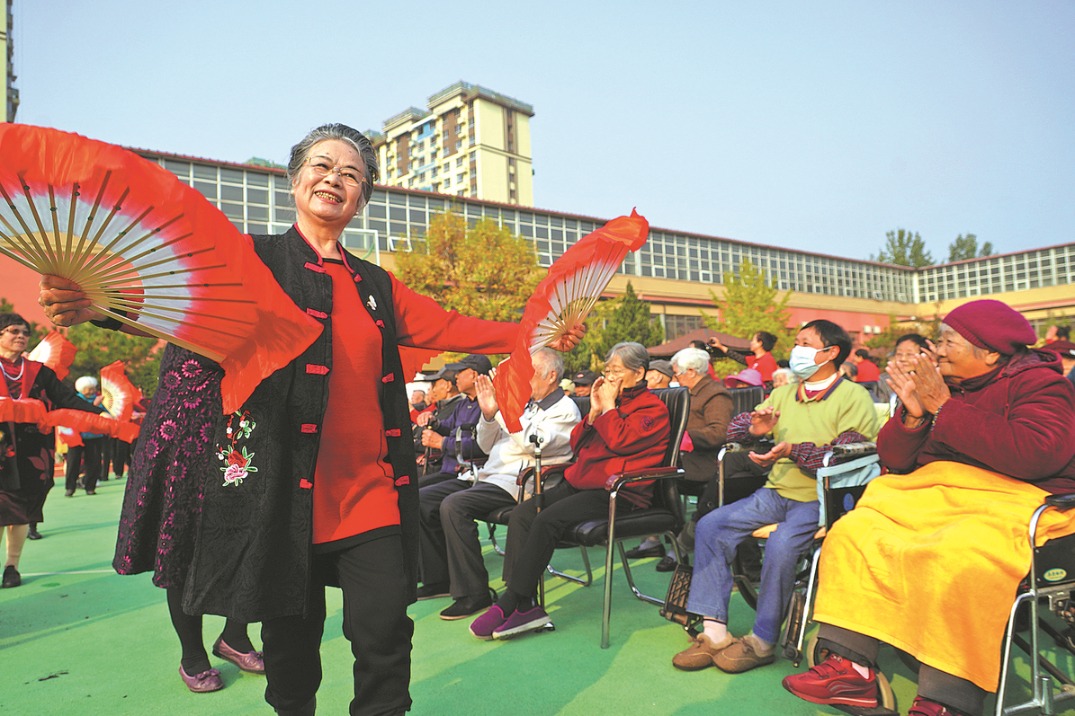A necessary and pragmatic reform


MA XUEJING/CHINA DAILY
With China entering the era of rapidly rising aging population, raising the retirement age has become a priority issue for the country. The decision to gradually increase the retirement age of men and women raises seven key points that are necessary for both policymakers and the public to understand.
Raising the retirement age according to gender and role: Over a 15-year period, starting in 2025, the government will raise the retirement age of men from 60 to 63 years and women blue-collar workers and women cadres from 50 to 55 years and 55 to 58 years, respectively. The gradual and phased approach will see male and female civil servants retire three months later each year, and female blue-collar workers six months later, until the new thresholds are reached by 2040.
Flexible retirement options: One of the most significant aspects of this reform is the flexibility it offers. Workers will be allowed to choose their retirement date within a three-year window, either retiring earlier or later than the statutory retirement age, provided they do not retire more than three years before or after the extended retirement age. This flexibility will allow workers to tailor their retirement plans according to their personal and professional circumstances.
Increasing minimum pension contribution period: Beginning in 2030, the minimum period for contributing to the basic pension program will gradually increase from 15 to 20 years. This incremental change, adding six months each year, reflects the reality of longer life expectancy and is aimed at ensuring that individuals contribute adequately to sustain the pension system.
Support for unemployed workers nearing retirement: For people close to retirement who are unemployed and getting unemployment benefits, the reform will provide extended unemployment benefits until they reach the new statutory retirement age. Also, during the transition period of delayed retirement, unemployment insurance funds will cover the pension contributions of such individuals.
Early retirement for workers in hazardous occupations: Workers engaged in physically demanding or hazardous jobs — such as mining, working at high altitude or in extreme temperatures — will be eligible for early retirement under a policy that remains unchanged, though the policy will be standardized and regulated more thoroughly.
Preventing age discrimination in employment: Age discrimination, particularly in the case of older workers, is a growing concern. The reform explicitly calls for stronger measures to prevent employment discrimination based on age, and encourages employers to hire older workers, in order to develop a more inclusive labor market.
Improving eldercare and childcare services: As part of broader reforms, the government plans to improve the eldercare and childcare systems, focusing on home-based and community-based services, alongside the development of affordable childcare. The idea is to support working families and ensure that retirees have access to necessary care services.
The reform not only aligns with China's changing demographic situation but also represents a necessary step toward sustaining social security and addressing the challenges of an aging society. Raising the retirement age is not a choice but a necessity, driven by several factors:
First, we are witnessing what can be termed "low-age aging". Between 2020 and 2050, the number of people aged between 60 and 69 is expected to increase from 150 million to 210 million, offering a window of opportunity for delayed retirement.
Second, China's life expectancy has significantly increased — from just 35 years in 1949 to 78.6 years in 2023. For those retiring at the ages of 50, 55 or 60, their post-retirement life has increased by several decades. We are entering an era of longevity, and the trend will only intensify.
Third, the dependency ratio — the number of working-age people supporting each elderly person — has become increasingly imbalanced. In 2023, each retiree was supported by roughly 2.96 working-age people, but by 2054, this figure will drop to just 1.15, putting tremendous pressure on the pension and social security systems.
In general, the health of elderly people, particularly those aged between 60 and 69, has been improving. In 2020, 93 percent of people in this age group were in good health or were basically healthy, creating a solid ground for extending people's working life.
People's education level, too, has been rising. The average number of years of schooling for the population aged 16 or above increased from 5.3 in 1982 to 9.9 years in 2020. With their education level improves, people are entering the workforce later, meaning if the retirement is not raised, the productive years of their lives will be shortened.
Advances in technology, automation and digitalization have made workplaces more accommodative for older workers. Heavy physical labor has decreased, and jobs have become more inclusive of both age and gender, providing opportunities for older adults to remain in the workforce longer.
The decision to raise the retirement age emphasizes three core principles: voluntarism, flexibility and gradualism. Workers will not be forced to retire at a specific age; instead, they can choose when to retire within a flexible period of time. The gradual implementation of the retirement system reform, across 15 years, ensures minimal disruption to the labor market and gives workers time to plan out their future.
China is not alone in facing the challenges of an aging population. Many developed countries have already raised their retirement age to 65 or above, with countries like Italy, Greece, Norway and the United States setting their retirement age at 67 or above. Most of these countries offer flexible retirement options and have been gradually raising the retirement age over time. China can learn from these experiences to create a system that balances the needs of individuals with the broader societal imperative to address the aging population problem.
Raising the retirement age in China is not just a pragmatic response to the demographic changes but an essential reform for the betterment of country's future. It offers flexibility for individuals, addresses the challenges of an aging society, and will help sustain the pension system. The sooner these reforms are enacted, the better China will be positioned to manage the inevitable aging of its population.
The author is vice president of the China Population Association and a professor of demography at Nankai University.
The views don't necessarily reflect those of China Daily.
If you have a specific expertise, or would like to share your thought about our stories, then send us your writings at opinion@chinadaily.com.cn, and comment@chinadaily.com.cn.
































